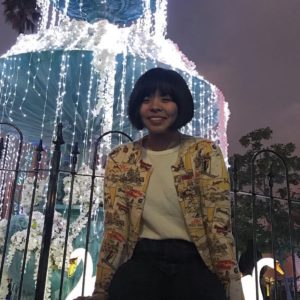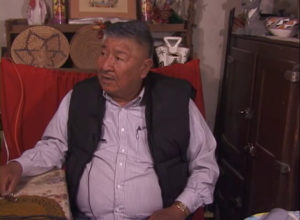By Miranda Jiang
Miranda Jiang is an Undergraduate Research Apprentice at the Oral History Center of The Bancroft Library at UC Berkeley. She is a UC Berkeley history major graduating in Spring 2022.

“I just can’t go out there with my Indian costume, because when I do that they might think, you know, oh, here comes a savage Indian.” — Irvin Shiosee
In 1942, Irvin Shiosee, a member of the Laguna Pueblo of the Southwest, moved with his family to Richmond’s boxcar village. Along with many members of the Acoma Pueblo, members of the Laguna Pueblo moved to this village (often referred to both as the Santa Fe Indian Village and the Richmond Indian Village) beginning in the 1920s. This migration followed a verbal agreement with the Santa Fe Railroad in California, which promised them employment in railroad maintenance and construction.
As part of the “Rosie the Riveter” project, the Oral History Center has conducted over 250 interviews with individuals who lived in the Bay Area during World War II, including people who lived in Richmond’s boxcar village. In his 2005 interview, Shiosee recalls his childhood there: he describes rows of around sixty boxcars placed along the railway, each housing one or more families. The children’s playground was a small “swamp” where they would take makeshift rafts and search for tadpoles. Among other anecdotes, Shiosee describes how his father built his family an oven to make sure they didn’t “lose any of [their] traditional food,” such as sweet “Indian pudding” made in the oven overnight.

Shiosee’s life within the village often seemed like a separate world from life outside and public school. Whereas day school at his old reservation was with other members of his tribe, at Peres Elementary School, there were Richmond-area children of many ethnicities. He had to learn English through Dick and Jane, and indigenous students were only allowed to speak English. He describes how students would “squeal on [them]” if they heard Shiosee or other Pueblo kids speaking Keresan. Subsequent punishments included standing against the wall or completing chores such as wood-chopping and cleaning the bathroom.
Shiosee also encountered stereotypical perceptions of indigenous people through his interactions with other children. On the first day of school, the teacher couldn’t pronounce his last name while introducing him to the class. He could see the surprise on his classmates’ faces upon hearing that he was an “American Indian boy.” The media only represented people like him in stories of “cowboys versus Indians,” so to these American children, indigenous people were the enemy.
“So that’s how they saw me,” he says, “as a savage Indian, I guess.”
Neither did the administration show much support. Children viewed him as a figure from fables and histories, and they would come up to pat him. When he whacked their hands away, teachers would send Shiosee to the principal’s office where he would be disciplined for fighting.
As Shiosee grew older, he became more and more aware of two separate realms. In his life outside the village, he knew he would face hostility if he showed his Pueblo identity. He describes walking to junior high school in the morning:
“I had to take off my Indian costume and hang it on this fence that I had to go through, and then put on my street clothes… ”
Yet despite going to school in an English-speaking environment and being pressured to assimilate, Shiosee remained closely connected with his culture and language. At the end of the interview, Shiosee describes his relationship with English and Keresan:
“English language to me is like I’m copying somebody. It’s not my natural language. The language that I speak comes from my heart on to you, you know. But to imitate somebody is not really from the heart. It’s coming from the mouth.”
In 1982, the Santa Fe Railroad shut off the power to the village. Although Richmond’s boxcar village was populated for around 60 years, it is now a relatively little known piece of Bay Area history. It has been documented in a number of writings, including essays by emeritus Oregon State University professor Kurt Peters (see “Boxcar Babies: The Santa Fe Railroad Village at Richmond, California, 1940-1945”). An event at Richmond’s Native Wellness Center in 2009 included three former inhabitants of the village as speakers, two of whom have interviews with the Oral History Center.
The boxcar village no longer exists physically, nor does it seem present in the Bay Area’s public consciousness. Although the inhabitants of the village attended local schools and events, and were spatially near other Bay Area neighborhoods, the Pueblo people preserved their culture and ways of life within the Richmond boxcar village. Ensuring knowledge of the Pueblo’s long history in the Bay Area is an important step towards recognizing what Shiosee already states in his interview: that rather than being faraway relics of history, he and his people are part of the present.
As a first step to learning more about the lives of Laguna and Acoma Pueblo people at this remarkable settlement, I encourage you to view the Rosie project’s compilation of interview segments related to the village. I further recommend reading and watching the full interviews, such as Irvin Shiosee’s interview.